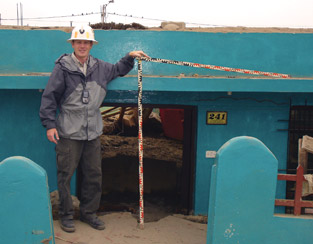
Following Earthquakes
Brady Cox's Career Has Led Him from Turkey to New Zealand to the White House
D18 member Brady Cox surveys earthquake damage in Peru.
Brady Cox, Ph.D., P.E., a member of ASTM International Committee D18 on Soil and Rock, is just 35 years old, but his career path has already taken him to some fascinating places: Turkey. New Zealand. Peru. And, most recently, to the White House.
Cox, an assistant professor in the Department of Civil, Architectural and Environmental Engineering at the University of Texas, was one of 96 recipients of the 2012 Presidential Early Career Award for Scientists and Engineers. The award is the highest honor given by the U.S. government to science and engineering professionals in the early stages of their independent research careers.
Following a presentation at the Smithsonian Institution, the award winners visited the White House, where they met President Barack Obama. Cox, who was honored for his work on geotechnical engineering issues, enjoyed learning about the work of his fellow award winners as well as the opportunity to meet President Obama.
"It really was a very special and unique opportunity," says Cox.
It was the reception of another award that led to Cox's ASTM membership. A paper co-written by Cox with Kenneth H. Stokoe and Ellen M. Rathje won the 2010 C.A. Hogentogler Award, given annually by D18 to the author(s) of a paper of outstanding merit on soil and/or rock for engineering purposes that has been published by ASTM. "An In Situ Test Method for Evaluating the Coupled Pore Pressure Generation and Nonlinear Shear Modulus Behavior of Liquefiable Soils" appeared in ASTM's Geotechnical Testing Journal in 2009. The paper is focused on the evaluation of earthquake-induced soil liquefaction, a phenomena that essentially shut down the city of Christchurch, New Zealand after an recent earthquake.
Cox attended D18 meetings during the week of the award presentation and joined ASTM shortly after. He is currently involved in several task groups working to refine standards assigned to D18.09 on cyclic and dynamic properties of soils.
"I became interested in ASTM at those first meetings and realized that the development of standards is an important part of our profession," says Cox.
Earthquakes became the focus of Cox's research after he accompanied his master's degree adviser at Utah State University to Turkey following a major earthquake there. His experience in Turkey has shaped Cox's continuing work, particularly on shear wave velocity measurements for earthquake site response studies.
Cox's work has also led him to become is an active member of the Geotechnical Extreme Events Reconnaissance (GEER) Association. Funded by the U.S. National Science Foundation, GEER sends teams of geotechnical experts to locations in the immediate aftermath of an extreme event, such as an earthquake or tsunami, in order to collect perishable data that can be used to advance the understanding of such events and their effects.
Through GEER, which is operated through the University of California, Berkeley, Cox has been part of teams to New Zealand, Haiti, Japan and Peru in the immediate aftermath of recent earthquakes.
"Any time there is a significant earthquake, the GEER steering committee meets to decide whether this is an event that we can learn something from," says Cox. "Can we see how facilities performed and are there new things we can learn from this earthquake?"
Learning new things about earthquakes is what Brady Cox's career is all about.
 SN Home
SN Home Archive
Archive Advertisers
Advertisers Masthead
Masthead RateCard
RateCard Subscribe
Subscribe Email Editor
Email Editor